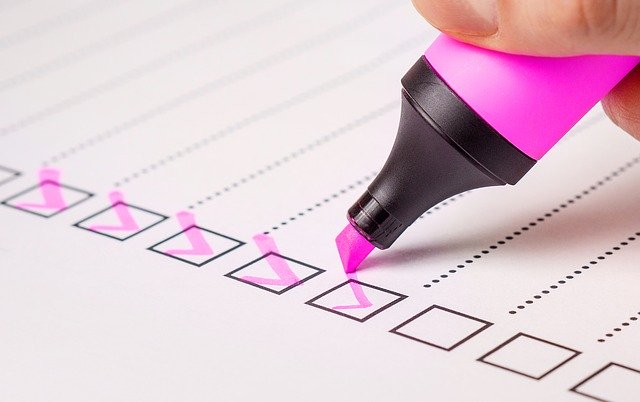December is a busy time or small and medium-sized businesses (SMBs). You’re selling products and providing services at a higher volume during the holiday shopping season. If December 31 ends your fiscal year, you’re getting ready for audits and tax prep. You’re probably also be trying to accomplish more in fewer days so you can take time off to attend school programs, retrieve students from college for break, or attend holiday events with family and friends.
All the hustle and bustle, however, doesn’t exempt you from your end-of-year responsibilities as a small business owner. Here’s a checklist that will remind you of things to do now or put on your calendar so that nothing slips through the cracks.
End-of-Year Checklist for Small Business
Take inventory
Whether you do physical counts or use an automated system, inventory is a critical metric for closing out the year’s records. Evaluating inventory at year-end can also provide you with information that will help you order more accurately next year, helping you to avoid markdowns, expired stock, and waste.
Pay contractors
Settling accounts with vendors is pretty straightforward, but you also need to make sure accounts with contractors (e.g., web designers, bloggers, videographers and photographers who are not employees of your business) are up to date so you can send them their 1099-MISC forms by the January 31 deadline.
Lower taxes
Talk to your accountant about making donations, paying bills and making purchases before the end of the year to minimize the amount of tax you will be required to pay.
Show appreciation to your clients
The holiday season is the perfect time to thank your clients for supporting your business throughout the year — and to let them know you would appreciate their loyalty in the new year. Contact your clients via mailers or email, and perhaps include a special offer. Sending client appreciation messages is also a good opportunity to make sure your client list is up to date and to calculate client retention. And, if you find that some of your customers haven’t made purchases in a while, consider offering them a special deal to bring them back to your business.
Send employee bonuses
If you give employees an annual bonus, it couldn’t come at a better time than the holidays when extra cash comes in handy. Work with your accountant to properly deduct taxes and get checks to your team in time. If you don’t give bonuses, consider a small token of appreciation to show your team that you value them and their work.
Update electronic files and subscriptions
More and more, SMBs depend on digital applications and file storage. Make sure your subscriptions are up to date and the plans you’ve chosen are adequate for the amount of storage you need. You should also set aside a time to close unused accounts and delete or archive old data — if a hacker gains access to your accounts, you want to have as little data as possible for them to find.
Assess IT for needed maintenance and security risks
Along those same lines, an end-of-year checklist for small business should include scheduling time to assess your IT systems for vulnerabilities to cyber risks or any maintenance they need. If you work with an experienced point of sale system (POS system) provider, you can leverage their expertise to make sure you’re doing all you need to do to keep your systems secure.
Update your website
Make arrangements to update your website (including copyright dates) so that it’s fresh and accurate in January.
Strategic planning
The end of the year is also time to establish goals and create a budget for improvements to your facilities, new directions, and expansions.
Also, Take Time to Think
December is not just a time to celebrate reaching the finish line of another year. It’s also time to think about how you got there. Study your profit and loss statement, POS reports, and other data at your disposal. Did you achieve the goals you set on Dec. 31 last year? When were your most successful times? Why? What did you do well? How can you do more of it in 2020?
Even though it’s a busy time, find time to evaluate your business’ performance and make plans for the upcoming year. It could be the most important thing on and end-of-year checklist for small business.
If you need help getting your POS system ready for another year of business, contact PlazSales.
To help pizzeria owners, pizza point of sale (pizza pos) is more than just a cash register or adding machine — it’s a hub where you can manage your entire business.
Pizza shops have long managed their business in the traditional, manual manner. Much like pizza itself, why stray too far from what has worked? This may mean using pen and paper to order ingredients, taking down orders over the phone. You may be using a non-integrated payment system to swipe credit cards. But that means workflows that take extra time through a shift and at the end of the day. Modern customers want the convenience of online ordering and payment. And like customers always have, they still expect prompt service and their food served warm and tasty as ever.
With Pizza POS, you can streamline your operations to reduce waste. It’s a win for everyone: The more efficiency you can build into your business, the more successful you will be at keeping your customers and employees happier.
Pizza POS Features
Point of sale systems for pizzerias are unique among those for other restaurants and businesses because pizzerias are a different kind of operation. Pizzas are almost endlessly customizable in a way that other restaurants are not expected to deal with. How big of a pie does a customer want? Which certain toppings only go on which certain halves? It’s easy for a mix-up or misunderstanding to occur when relaying these orders verbally and recording them manually. Better to have a system that is designed and optimized for these specific kinds of orders.
Pizza POS systems need to give your business these capabilities:
- Modify options for size and toppings on pizzas. When the menu changes, the system can easily adapt as well.
- Inventory management that lets you know exactly what you have, how much you use, so you never run out of ingredients while reducing food waste.
- Online ordering to suit busy customers’ schedules and for added convenience.
- Delivery management to provide your delivery drivers with directions and constant traffic updates to get them where they need to be on time. You can also let your customers know when their delivery is dispatched so they aren’t left guessing.
- Loyalty program features to keep your customers coming back by rewarding them for doing so. The right pizza POS system will allow you to digitally manage your customer accounts and rewards with ease.
- Customer relationship management (CRM) that allows you to optimize your sales and marketing campaigns, forecast future sales, and automate simple digital features to leave your staff more time for complex tasks.
- Integrated payments — no longer take that extra time at the end of the day to do your payment reports.
- Offline mode for business continuity, even if your network connection is interrupted
- Reporting that provides you with visibility into what your customers are ordering, their preferred methods of payment, the times the rush comes in, and track labor hours and employee performance.
Just What You Ordered
In this day and age, pizzerias face steep competition and small profit margins. To keep operating while making a profit, you need the ability to operate efficiently and build a base of loyal customers. When it comes to optimizing your business, in all specifics unique to pizzerias, pizza POS can help.
To learn more about point of sale systems that help pizzerias run efficiently and profitably, contact PlazSales.
For more tips, information, and insights, subscribe to our blog. It only takes a few seconds to subscribe by entering your email address.


Recent Comments